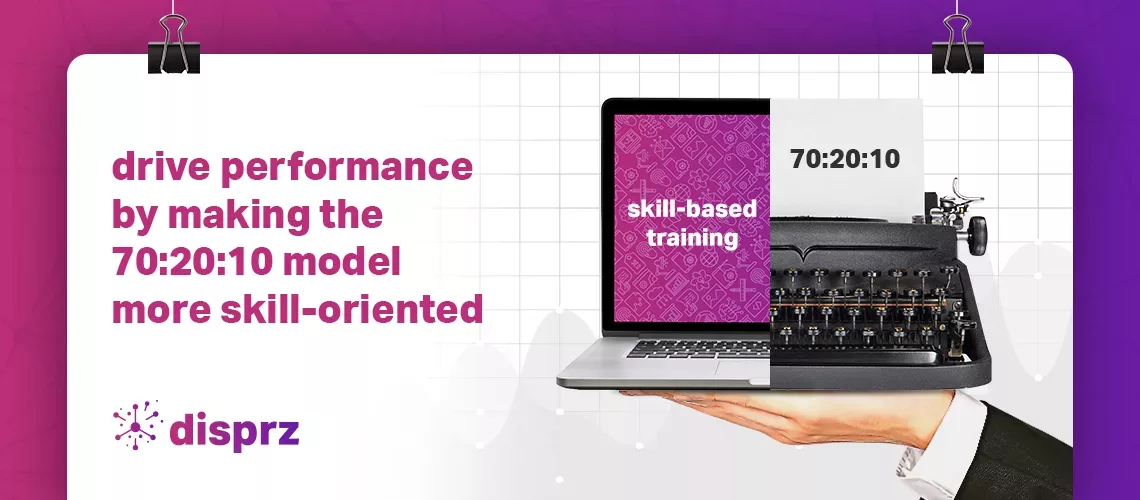Over the past few decades, the 70-20-10 learning model has become a cornerstone for learning and development models. This innovative framework emphasizes experiential, social, and formal learning to optimize employee growth and productivity. Companies embracing the 70:20:10 model for learning and development have seen significant improvements in skill acquisition and workforce engagement.
The 70-20-10 learning model is undoubtedly effective, but it requires a fresh approach when it comes to upskilling your employees. Ironically, many teams and leaders still struggle to seamlessly integrate this model into their L&D strategy, as traditional implementation approaches fall short of delivering expected results. Making a shift towards skill-based training can provide a positive direction for harnessing the full potential of the 70-20-10 learning model.
Before we get to the new approach, let’s dive deep into the basics first.
What is the 70-20-10 learning model?
The 70:20:10 model of learning suggests that employees learn best through a mix of on-the-job training (70%), social learning (20%), and formal education (10%). This 70 20 10 learning strategy aligns with real-world business needs, offering a practical approach to skill-building and professional development.
The model's goal is to encourage leaders, managers, and team members to perceive learning and development (L&D) as an integral part of their everyday roles, rather than an optional extra or something reserved for the L&D department.
The framework of this 70-20-10 model for learning is broken down to:
-
70% of learning happens through on-the-job experience.
-
20% of learning happens through social interactions
-
10% of learning happens through formal learning
While historically, this model has been extremely effective, digital acceleration and the ever-changing market space demand a skill-based approach to tackle business challenges. For this reason, the traditional model requires modernization and a greater emphasis on skill development to upskill and reskill your employees in the digital-first era.
Why Use the L&D Model?
Incorporating an effective L&D model, such as the 70 20 10 framework, offers strategic advantages. It helps organizations adapt to change, drive innovation, and retain top talent. This 70:20:10 development model equips employees with skills aligned to their roles, boosting productivity and organizational success.
Here are the key reasons behind using the L&D model
Enhanced Employee Skills
The L&D model provide structured training and development opportunities for employees. This leads to improved skills, knowledge, and expertise, which can boost their performance and productivity.
Increased Employee Engagement
When companies invest in the growth and development of their employees, it fosters a sense of value and loyalty. Engaged employees are more likely to stay with the organization, reducing turnover and its associated costs.
Adaptation to Industry Changes
Industries are constantly evolving. The L&D model ensures that employees are up-to-date with the latest industry trends, technologies, and best practices, making the company more adaptable to changes and competitive in the market.
Talent Development and Retention
The L&D model serves as a powerful strategy for identifying and nurturing talent within the organization. By providing growth opportunities, companies can groom their employees for leadership roles, reducing the need to hire externally.
Improved Organizational Performance
Ultimately, a well-implemented L&D model leads to better overall organizational performance. Employees are equipped with the skills and knowledge to excel in their roles, contributing to the company's growth and success.
Importance of Enhancing the 70-20-10 Learning Model with Upskilling
The 70-20-10 model has been widely praised for improving learning and development outcomes. However, some critics highlight its lack of structure, particularly the 70% experiential learning component. By aligning the 70:20:10 learning and development model with structured upskilling strategies, organizations can address these gaps and enhance employee growth.
However, it’s important to remember that the 70-20-10 model is only a guideline and can be customized to meet an organization’s specific learning and development needs. With structured upskilling strategies, employees can direct their L&D efforts in a positive direction. By identifying and developing the necessary skills, employees can expand their capabilities and drive their performance.
How to enhance the 70-20-10 learning model in 2024?
The 70:20:10 approach to learning emphasizes experiential, social, and formal learning as essential components of L&D success. To align with evolving business needs in 2024, companies must adopt a skill-based approach that integrates these elements into their talent development strategies.
Here is how skilling can be blended with the 70:20:10 learning model to drive impact.
Connect roles with essential skills
Modern companies are advancing toward digital maturity, making the 70:20:10 development philosophy a critical tool. Employees can connect roles with essential skills using platforms like Disprz, enabling a clear pathway for 70-20-10 implementation in the workplace.
Employees need more clarity on their roles and the capabilities they have to build to shape their career paths. For instance, if skills are defined for a digital marketing executive, assistant manager, and manager. The employee will know which skills they need to develop to do their job efficiently or move to the next role.
A skilling suite, like Disprz, helps in identifying and benchmarking skills for different roles in a company. It even enables managers and employees to measure the proficiency level for each skill.
For instance, on a scale of 1 to 10, the manager rates an employee 4 for a particular skill, and in self-assessment, the employee also rates himself 4, so his skill score will be 4.
Based on the skill score, the employee gets a clear understanding of how much effort he has to put in to build the skills for moving to the next role. So accordingly, he can coordinate with employees who are experts in a particular skill. He can self-enroll in various courses and practice what he has learned to get better at a particular skill. Here the employee is still doing experimental learning, but it is a more streamlined way.
Read how Petronas leveraged Disprz LXP to tailor individualized development paths for each role.
Upskill through peer-generated content and employee engagement
Leveraging peer-generated content enhances the 70 20 10 approach to talent development. Employees can share expertise, collaborate on projects, and engage in meaningful social learning activities to complement their on-the-job experiences.
For instance, there are three sales executives in a team, and the skills are benchmarked for the sales executive role. Through a skill assessment, they find out that all three are good at different skills; for instance, one is good at cold calling, the other is good at setting appointments, and the third is good at giving sales presentations. So all three can share the techniques that worked really well with each other.
The company can empower them by giving them the right learning tool with a social platform where they can collaborate with peers, share valuable resources, and brainstorm together. Social learning aligned with a skill-driven approach can help boost engagement and results.
Read how Deloitte leverages Disprz LXP for AI-powered content recommendations, engaging social features, and a lot more.
Define a personalized learning pathway
The 10% of formal learning in the 70 20 10 principle can be enhanced through AI-driven personalized pathways. LXPs tailor content recommendations to individual learner needs, making the 70 20 10 model training more impactful.
Most of the LXP solutions are powered by AI that recommends relevant courses based on the learner’s skills and interests. This helps take personalization to the next level for developing necessary skills in real-time.
Leverage Employee Upskilling Technology
The 70-20-10 methodology remains effective when integrated with cutting-edge upskilling technologies. Disprz LXP helps organizations implement the 70-20-10 innovation model by providing AI-powered recommendations, skill assessments, and tailored content for modern workplaces.
Disprz LXP gives employees the flexibility to explore skills that interest them, all while driving learning initiatives that seamlessly blend with the business goals. This powerful AI-based platform provides personalized and intelligent learning recommendations based on the job role, interest, skills, and the employees’ learning preferences.
Conclusion
The 70:20:10 model for learning has been a cornerstone of employee development. By embracing its flexibility and enhancing it with skill-based training, organizations can address the evolving demands of the digital-first era. With modern learning experience platforms like Disprz, the 70 20 10 learning and development model can drive measurable results in talent development and workforce engagement.
By integrating skill development into the 70-20-10 model, organizations can empower their workforce to excel in today's digital-first landscape, achieving both individual and organizational success.









